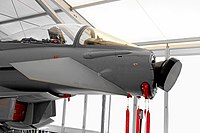
Photo from wikipedia
This paper presents a millimeter-wave phased-array receiver front-end with compact size and low-power consumption. A combination of local oscillator (LO) and radio frequency (RF) phase-shifting schemes is used to reduce… Click to show full abstract
This paper presents a millimeter-wave phased-array receiver front-end with compact size and low-power consumption. A combination of local oscillator (LO) and radio frequency (RF) phase-shifting schemes is used to reduce the power consumption and RF path loss. Moreover, in the implementation of active circuits, a bulk isolation technique is used to achieve a higher power gain with a minimum number of stages. This technique is also utilized in the RF path phase shifter switches to mitigate the loss. To validate the proposed architecture, a single-element 56-to-66 GHz phased-array receiver front-end is fabricated in a 65-nm bulk CMOS process. Based on the measurement results, the receiver achieves a power gain of ~14.85 dB and a minimum noise figure (NF) of 5.7 dB. The measured average RMS phase and gain errors are ~3.5° and ~0.45 dB, respectively. The input 1-dB compression point ( $\text{P}_{\mathrm {-1dB}}$ ) of the receiver chain is about −19 dBm. The complete receiver, including active balun and required buffers (excluding the LO), consumes ~50 mW from a 1-V power supply and excluding the pads occupies a silicon area of 0.93 mm2.
Journal Title: IEEE Transactions on Circuits and Systems I: Regular Papers
Year Published: 2020
Link to full text (if available)
Share on Social Media: Sign Up to like & get
recommendations!